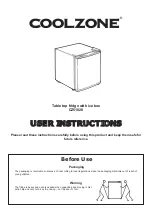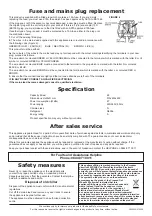
The appliance is designed to operate at normal room
temperatures. Position it away from any heat source such as a
boiler, oven or heater which will reduce the cooling efficiency
of the fridge. It is also not advisable to install the appliance in
unheated locations such as garages or outbuildings, as these
will impair the operation of the fridge in winter.
The fridge requires space around the casing for efficient
cooling and operation. The minimum clearances are shown in
Figure 5.
The fridge must be installed on a firm, flat and level surface for
it to work quietly and efficiently. If necessary, turn the
thumbwheel foot to level the appliance.
Switching on
Plug the fridge into a nearby power socket and switch on. A
humming from the compressor will indicate that the fridge is
running.
Temperature control
Turn the thermostat control to the NORMAL position on the
dial and leave the fridge running with the door closed for
approximately 2 hours. This will allow the inside temperature to
stabilise.
If you wish to decrease the temperature inside the fridge, turn
the thermostat control to a higher number.
Note: The setting on the thermostat control is dependent upon
room temperature and the external temperature.
Page 3
Installation and controls
FIGURE 5
Important
Make sure that the voltage marked on the rating label on the product corresponds with the voltage in your home.
This quality product has been tested and certified to meet all applicable UK electrical and safety standards.
The diagram shows the correct air flow allowance that should
be left around the appliance.
10cm
2cm
10cm
Notes on operation
During normal operation the following noises may be heard:
O
Stifled murmur from compressor when it is working.
O
Soft gurgling from the coolant flowing through the cooling
system.
O
Click from the thermostat switching on and off.
Maintenance and cleaning
Important: The fridge must be turned off at the mains before
maintaining or cleaning. It is recommended to clean and wipe
out the fridge after any spillage inside or outside the appliance.
It is wise to defrost the condenser if the ice build up exceeds
6mm, otherwise the efficiency of the fridge will reduce and the
electricity consumption will increase.
Caution: Do not touch ice with bare skin to avoid ‘ice
burns’.
Unplug and remove the fridge contents.
Leave the door open until ice has melted. Alternatively, a bowl
of hot (not boiling) water placed under the condenser will
hasten defrosting. A plastic scraper may be used as an aid to
defrosting.
O
Do not use electrical appliances such as heaters or hair
dryers to melt the ice.
O
Do not use metal objects such as knives or skewers to chip
away the ice as these can damage the condenser.
Finally, wipe the interior surfaces and door seal using a
teaspoonful of bicarbonate of soda diluted in a pint of warm
water to remove any residues or odours.
Keep water away from the thermostat housing.
Keep the compressor motor (located at rear of casing) free
from dust to maintain optimum efficiency. Use a soft brush or
vacuum cleaner to remove the dust, taking care not to damage
the pipes and wiring.
The external casing can be cleaned with warm soapy water
and protected by polish. Do not use scouring powders which
can scratch the surface.
Note: If leaving the fridge unused for a prolonged period,
unplug from mains, defrost, wipe dry and leave the door open.
Problem
Possible cause
Remedy
Appliance does not run
No power
Check power is switched ON
Faulty fuse
Check fuse in plug
Thermostat setting too low
Turn thermostat setting higher
Fridge is not cold enough
Door is open for too long
Do not open door needlessly
Located too near a heat source
Relocate appliance
Inadequate airflow around appliance
See Figure 5
Abnormal noise and vibration
Appliance not level
Choose a level surface
Troubleshooting






















